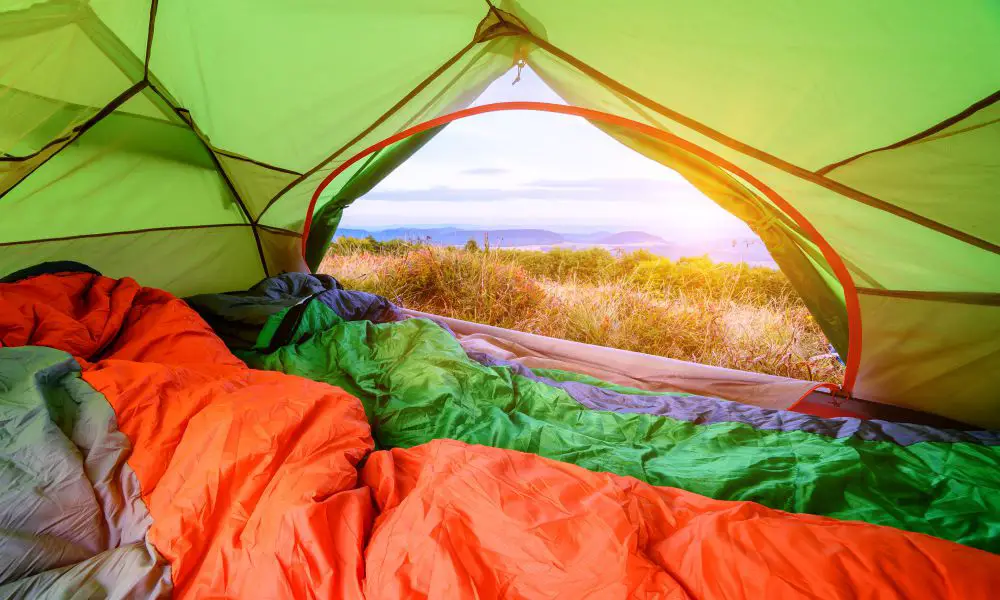Anyone who camps regularly would like their sleeping bag to last more than a few summers. You will find the longevity of a sleeping bag depends on its quality and how you take care of it.
A quality sleeping bag should last a minimum of 5 years, but some will last up to 10-15 years depending on how much you use it and how you take care of it.
The first aspect of finding a long-lasting sleeping bag is to look at quality.
How Long Does a Sleeping Bag Last?
Buy a Quality Sleeping Bag
Sleeping bags come at all price points on the market. You don’t need to buy the most expensive one as some of the cheaper ones will last well past a decade or two. Look for quality in the manufacturing of the bag.
Look at the stitching. Make sure they are tight and well done.
Look at the zipper. Make sure it works well and slides easily. Most problems with sleeping bags occur with zippers.
Buy the right bag for the type of camping you are doing. Sleeping bags have different temperature thresholds for use. Some are made for extreme cold and wet weather while others are made more for summer camping. Make sure the bag you choose is for the right purpose and temperature if you plan on going somewhere where there are extreme temperatures either way.
Check to see what material makes up the filling. There are differences in how different fillings handle weather and washing. Down vs. SyntheticSome discussion exists about whether the down or synthetic filling is the better option. There are advantages and disadvantages to both.
Overall, down tends to win the hearts of campers because it is highly durable, is compressible and light, and has a great weight-to-warmth ratio. However, down-filled sleeping bags are more expensive. One negative about down is that it is a mess if it gets wet. It becomes non-insulating, heavy, and awful to carry.
The industry has developed a new version of down that allows hydrophobic coatings to attach to filaments resulting in “dry down.” It isn’t waterproof at all but can help keep the loft up.
A good side item for any sleeping bag, but particularly down, is a waterproof sack to travel with your bag. It will keep your sleeping bag dry during hiking or travel in case the weather doesn’t cooperate with your camping trip.
Synthetically insulated sleeping bags can’t be guaranteed to last past 10 years, but they do keep you warm even when they are wet and dry quickly. They are great for people with allergies and are cheaper.
No matter which version you get, it helps to invest in a few other camping items to improve your sleeping bag’s longevity.
Items That Improve Your Sleeping Bag’s Longevity
Three items can make a real difference in how long your sleeping bag lasts. They are:
- A separate mesh bag for storage.
- A sleeping mat
- A liner
Many people don’t realize that a sleeping bag isn’t meant to stay rolled up in the tightly compressed bundle. While that is great for hiking and traveling, keeping it bundled will eventually break down the filling.
Buy a bag that comes with two storage sacks or buy a separate storage sack. The smaller sack is to stuff your sleeping bag in for travel. The larger bag is typically made of a breathable fabric like mesh. It is to store your sleeping bag when camping season is over.
This bag allows the sleeping bag to be looser and uncompressed for storage.
A sleeping mat is a water-resistant mat you place on the floor of your tent so your sleeping bag isn’t directly on the ground. This keeps it from getting dirty and wet from dew or rain.
A sleeping bag liner is probably something newer campers aren’t familiar with, but it is a sack made of lightweight material that fits inside the sleeping bag. It serves two purposes in that it provides some extra insulation and helps to keep the sleeping bag clean.
It may also feel more comfortable than the interior of the sleeping bag. A liner is easier to clean after camping than the entire bag so it helps lengthen the life of your sleeping bag.
Know Your Sleeping Bag’s Limits
While your sleeping bag is durable enough for outdoor weather, it may not be durable around things like campfires. Sleeping bags are meant to be used inside tents, not outside near fires.
First, you need to be sure your sleeping bag won’t easily catch fire. Some brands are more fire-resistant than others. Second, even the best sleeping bags aren’t meant to withstand extreme heat like from a campfire.
A campfire can damage smaller parts like zippers and snaps, depending on their construction material. Wrap yourself in a blanket while enjoying the fire and save the sleeping bag for the tent.
How to Store Your Sleeping Bag
Most camping experts say you shouldn’t just stuff your sleeping bag away once the season is over if you want your bag to last. One way to store it, beyond the mesh storage bag, is to hang it up to air. This should be done out of direct sunlight.
You can use the loops on the bag’s front side to hang in a dry place. At the very least, you should air it out at the beginning and end of each camping season. Make sure it is clean and dry after each camping trip before storage.
How to Wash Your Sleeping Bag
Sleeping bags are going to need washing after a few days in the woods. There are special detergents and ways to wash different kinds of sleeping bags, so read the instructions for your particular bag before you buy it.
Down sleeping bags require a special detergent because traditional laundry detergent strips the feathers of natural oils. These oils protect the down and help it trap air, which makes the sleeping bag warmer.
Reducing the oils will make the sleeping bag less effective and it will wear out faster.
Even synthetic bags may require a special branded detergent for washing, depending on the fill material. There are base washes made for camping equipment that usually works well, so you can check with an outdoor supply store to see what’s available.
Sleeping bags, whether they are down or synthetic filled, can be put in a dryer as long as it is on a low setting. Down sleeping bags benefit from you putting a couple of tennis balls in the dryer when it’s about halfway dry. That keeps the insulation’s loft high and breaks up down clumps.
Repairing Your Sleeping Bag
It never hurts to learn a thing or two about making basic repairs to your sleeping bag. That may mean learning how to stitch a patch, fix a zipper or use a special tape made to attach to nylon to cover tears or holes. Knowing the basics of sleeping bag repairs will help your bag last longer.
Conclusion
Any number of sleeping bags can last a lifetime of camping. The secret is buying a quality bag that suits your camping style and knowing how to clean, store and repair it between seasons. A sleeping bag is an investment and maintaining it will make it a long-running one.

